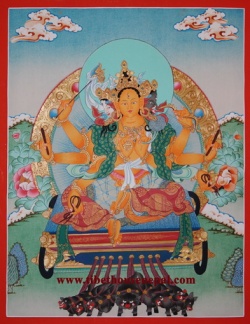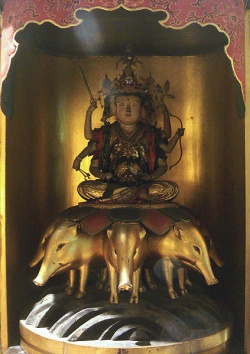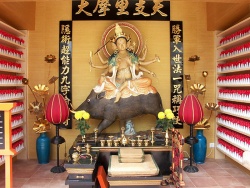Marichi
In Mahayana and Vajrayana Buddhism, Marici is a deva or bodhisattva associated with light and the sun. She is known as Molizhitian (摩利支天) or Molizhitian Pusa (摩利支天菩萨) in China and Marishi-ten (摩利支天?) in Japan. She is one of the Twenty (or Twenty Four) Celestials (二十/二十四诸天). In Taoism, Marici is known under the epithet of the Dipper Mother (traditional Chinese: 斗母元君; pinyin: Dǒumǔ Yuánjūn).
Iconography
Marici is usually depicted in one of the following ways:
- As a beautiful woman on an open lotus, the lotus itself sometimes perched on the back of seven sows.
- As a ferocious wrathful deity perched on the back of a boar.
- Riding a fiery chariot pulled by seven savage boars or sows.
- As a multi-armed woman with a different weapon in each hand standing or sitting on the back of a boar.
She has been depicted with one, three, five or six faces and two, six, eight, ten or twelve arms; three eyes; in her many-faced manifestations one of her faces is that of a sow.
Origins
The origins of Marici are obscure, however, she appears to be an amalgamation of Brahmanical, Iranian, and non-Aryan antecedents spanning 1500 years.
China
Marici in China is worshiped as both a Buddhist and Taoist deity where she is known as Dipper Mother (traditional Chinese: 斗母元君; pinyin: Dǒumǔ Yuánjūn) or Maritchi Deva (traditional Chinese:摩利支天菩萨; pinyin: Mólìzhītiān Púsà). Most often she depicted with three eyes in each of her four faces; with four arms on each side of her body. Two of her hands are held together, and the other six hold a sun, moon, bell, golden seal, bow, and halberd. She is either standing/sitting on top of a lotus or pig, or on a Lotus on top of seven pigs. She is celebrated on the 9th day of the 9th lunar month.
In Chinese Buddhism, especially in the south where Tantric Buddhism hardly penetrated, she is often confused with Cundī. Among Chinese Buddhists she is worshiped as goddess of light and as the guardian of all nations, whom she protects from the fury of war.
In Taoism she remains a popular deity and is often referred to as Queen of Heaven (traditional Chinese: 天后; pinyin: Tiān Hòu) and is widely worshiped as the Goddess of Beidou (the Chinese equivalent of Ursa Major except that it also includes 2 "attendant" stars). She is also revered as the mother of the Nine Emperor Gods who are represented by the nine stars in the Beidou constellation. Legend has it that one spring day a queen went to bath in a pond. Upon entering she suddenly felt "moved" and nine lotus buds rose from the pond. Each of these lotus buds opened to reveal a star which then became the Beidou constellation.
She is still worshiped today in Taoist temples like the White Cloud Temple and the Tou Mu Kung Temple which has both Taoist and Buddhist influences.
Japan
An important deity in the Shingon and Tendai schools, Marici was adopted by the Bujin or Samurai in the 8th century CE as a protector and patron.
While devotions to Marici predate Zen, they appear to be geared towards a similar meditative mode in order to enable the warrior to achieve a more heightened spiritual level. He lost interest in the issues of victory or defeat (or life and death), thus transcending to level where he became so empowered that he was freed from his own grasp on mortality. The end result was that he became a better warrior.
The worship of Marici was to provide a way to achieve selflessness and compassion through Buddhist training by incorporating a passion for the mastery of the self.
Samurai would invoke Marici at sunrise to achieve victory. Since Marici means "light" or mirage, she was invoked to escape the notice of one's enemies.
She was also later worshipped in the Edo period as a goddess of wealth and prosperity by the merchant class, alongside Daikoku-ten (大黒天) and Benzaiten (弁財天) as part of a trio of "three deities" (santen 三天).
====[[Wikipedia:Ed
o period|Ed
o period]]====
She was also later worshipped in the Edo period as a goddess of wealth and prosperity by the merchant class, alongside Daikokuten (大黒天) and Benzaiten (弁財天) as part of a trio of "three deities" (santen 三天).
As a Yaksha General
Marici has also sometimes included as one of the twelve Yaksha Generals associated with Bhaisajyaguru, the Buddha of Medicine.
An important deity in the Shingon and Tendai schools, Marici was adopted by the Bujin or Samurai in the 8th century CE as a protector and patron.
While devotions to Marici predate Zen, they appear to be geared towards a similar meditative mode in order to enable the warrior to achieve a more heightened spiritual level. He lost interest in the issues of victory or defeat (or life and death), thus transcending to level where he became so empowered that he was freed from his own grasp on mortality. The end result was that he became a better warrior.
The worship of Marici was to provide a way to achieve selflessness and compassion through Buddhist training by incorporating a passion for the mastery of the self. She was also later worshipped in the Edo period as a goddess of wealth and prosperity by the merchant class, alongside Daikoku-ten (大黒天) and Benzaiten (弁財天) as part of a trio of "three deities" (santen 三天).
In Mahayana and Vajrayana Buddhism, Marici is known as the Goddess of the Heavens, Goddess of Light, and a solar deity. Also known elsewhere as Marishi-ten (摩利支天?), Marisha-Ten (another Japanese name) and Mólìzhītiān Púsà (Chinese: 摩利支天菩萨; pinyin: Mólìzhītiān Púsà).
She is believed to be one of the Twenty (or Twenty Four) Heaven Celestials (二十/二十四诸天). Lying 15 km west of Kunming City, the Dragon Gate (Long Men) in the Western Hills is close to the west shore of Dianchi Lake.
It consists of the Sanqing Temple Complex and the Dragon Gate Grotto Complex. Dragon Gate is over 2,300 meters, 300 meters higher than the water surface of Dianchi Lake.
In Taoism, Marici is known under the epithet of the Dipper Mother (traditional Chinese: 斗母元君; pinyin: Dǒumǔ Yuánjūn). Western Hills Forest Reserve (simplified Chinese: 西山森林公园; traditional Chinese: 西山森林公園; pinyin: Xī Shān Sēnlín Gōngyuán) lies in the Biji Mountain chain to the west of Kunming, China.
It is visible from the eastern or northern banks of Dianchi Lake.
Marichi (Skt. mārīcī) or Özerchenma (Wyl. 'od zer can ma) is the Goddess of the Dawn.
External links
Source
Marichi, Kalpoktam (Tibetan: o zer chen ma, English: the One Having Light Rays), Goddess of the Dawn.
Marichi is a red-coloured female yidam associated with the sun and with dawn. She has three faces (including a sow's face); her eight arms holding various implements, and she rides a throne/chariot drawn by nine pigs. Her mantra is traditionally used as protection by travellers.
The goddess Marichi is another of the twenty-one forms of Tara and has the special power to avert bandits, robbers, and thieves. She is a most sublime goddess who is the ally of beings who are bereft of companionship and support and who are subject to the coercion of others more powerful than they.



